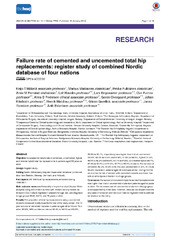| dc.description.abstract | Objective: To assess the failure rate of cemented, uncemented, hybrid, and reverse hybrid total hip replacements in patients aged 55 years or older. Design: Register study. Setting: Nordic Arthroplasty Register Association database (combined data from Sweden, Norway, Denmark, and Finland). Participants: 347 899 total hip replacements performed during 1995-2011. Main outcome measures: Probability of implant survival (Kaplan-Meier analysis) along with implant survival with revision for any reason as endpoint (Cox multiple regression) adjusted for age, sex, and diagnosis in age groups 55-64, 65-74, and 75 years or older. Results: The proportion of total hip replacements using uncemented implants increased rapidly towards the end of the study period. The 10 year survival of cemented implants in patients aged 65 to 74 and 75 or older (93.8%, 95% confidence interval 93.6% to 94.0% and 95.9%, 95.8% to 96.1%, respectively) was higher than that of uncemented (92.9%, 92.3% to 93.4% and 93.0%, 91.8% to 94.0%), hybrid (91.6%, 90.9% to 92.2% and 93.9%, 93.1% to 94.5%), and reverse hybrid (90.7%, 87.3% to 93.2% and 93.2%, 90.7% to 95.1%) implants. The survival of cemented (92.2%, 91.8% to 92.5%) and uncemented (91.8%, 91.3% to 92.2%) implants in patients aged 55 to 64 was similar. During the first six months the risk of revision with cemented implants was lower than with all other types of fixation in all age groups. Conclusion: The survival of cemented implants for total hip replacement was higher than that of uncemented implants in patients aged 65 years or older. The increased use of uncemented implants in this age group is not supported by these data. However, because our dataset includes only basic information common to all national registers there is potential for residual confounding. | en_US |

